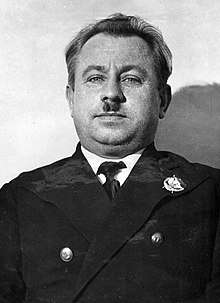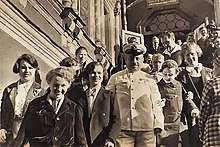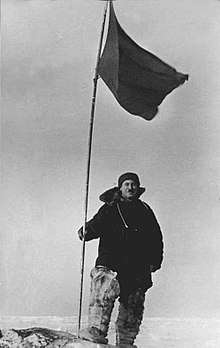Ivan Papanin
Ivan Dmitrievich Papanin (Russian: Иван Дмитриевич Папанин, 26 November [O.S. 14 November] 1894 – 30 January 1986) was a Soviet polar explorer, scientist, Counter Admiral, and twice Hero of the Soviet Union, who was awarded nine Orders of Lenin.
Ivan Dmitrievich Papanin | |
|---|---|
 | |
| Born | 26 November 1894 Sevastopol, Russian Empire (now Crimea Peninsula) |
| Died | 30 January 1986 (aged 91) Moscow, Soviet Union |
| Nationality | Soviet Union |
| Occupation | Polar explorer, scientist |
Life and career
Early life, participation in the Red Terror

Ivan was born in Sevastopol into the family of a sailor of Russian Greek origin. In 1914 he was conscripted into the Imperial Russian Navy. He took part in the Russian Civil War on the Bolshevik side, fighting in Ukraine. In 1920 he was sent to the Crimea to organize a guerrilla movement against the forces of the White Movement leader General Baron Pyotr Wrangel.
In November 1920, after the Bolshevik takeover of Crimea, Papanin was appointed prosecutor and commandant of the Crimean branch of the Soviet secret police, the Cheka. Rosalia Zemlyachka, organizer of the Red Terror in Crimea, is reported to be his superior and friend.[1][2] During the Red Terror in Crimea, thousands of soldiers were executed as members of the White Army.
As polar explorer
In 1923-1932 he worked for Narkomat of Communications. In 1931 he took part in the expedition of the icebreaker Malygin to Franz Josef Land. In 1932-1933 he was the head of a polar expedition on Tikhaya Bay on Franz Josef Land. In 1934-1935 he was in command of a polar station on Cape Chelyuskin.
In 1937-1938 he was in charge of the famous expedition North Pole-1.[3] Four researchers, Ivan Papanin, Ernst Krenkel, Yevgeny Fyodorov and Petr Shirshov, landed on the drifting ice-floes in an airplane flown by Mikhail Vodopyanov. For 234 days, Papanin's team carried out a wide range of scientific observations in the near-polar zone, until taken back by the two icebreakers Murman and Taimyr. It was the first expedition of its kind in the world. All members of the expedition received the title of Hero of the Soviet Union, which was extremely rare before World War II.
In 1939-1946 Papanin was the successor to Otto Schmidt as head of the Glavsevmorput' (Glavniy Severniy Morskoy Put') - an establishment that oversaw all commercial operations on the Northern Sea Route. In 1940 he received a second Hero of the Soviet Union title for organizing the expedition that saved the icebreaker Sedov. During World War II he was the representative of the State Defence Committee (Gosudarstvennij Komiet Oborony) responsible for all transportation by the Northern Sea Route. In 1941-1952 he was a member of the Central Revision Commission of the Communist Party.
In 1948-1951 he was the deputy director of Institute for Oceanology of the USSR Academy of Sciences and from 1951 until his death in 1986 he was the Head of the Academy's Department of Maritime Expeditions. In 1956-1972 he was also the director of the Institute for the Biology of Inland Waters (Bilogii Vnutrennikh Vod).
Papanin's name has been given to a cape on the Taimyr Peninsula, a mountain in Antarctica, and an underwater mountain in the Pacific Ocean. Ivan Papanin's name was also given to an ice-class cargo and research ship (call sign: UCJE) built in 1990 that operates in both Arctic seas and the Antarctic. In October 2019, Russia unveiled the 8,500-tonne, 300-foot-long Ivan Papanin icebreaker at the Admiralty Shipyard in St Petersburg.[4]
Honours and awards
- Hero of the Soviet Union (1937, 1940)
- 9 Orders of Lenin (1937, 1938, May 1944, November 1944, 1945, 1956, 1964, 1974, 1984)
- Order of the October Revolution (1971)
- Order of the Red Banner, twice (1922, 1950)
- Order of Nakhimov, 1st class (1945)
- Order of the Patriotic War, 1st class (1985)
- Order of the Red Banner of Labour, twice (1955, 1980)
- Order of Friendship of Peoples (1982)
- Order of the Red Star (1945)
- Medal for Combat Service
- Jubilee Medal "In Commemoration of the 100th Anniversary since the Birth of Vladimir Il'ich Lenin"
- Jubilee Medal "XX Years of the Workers' and Peasants' Red Army"
other medals and foreign decorations.
- Doctor of Geography (1938)
- Rear-Admiral (1943)
- Honorary Citizen of the Hero City of Murmansk (1974), Arkhangelsk (1975), Hero City of Sevastopol (1979), Lipetsk and the Yaroslavl Region
References
- Матрос, чекист, полярник. За что уважают и ненавидят Ивана Папанина? [Seaman, chekist and polar explorer. For what do people respect and hate Ivan Papanin?] - Andrey Sidorchik, Argumenty i fakty, 26 November 2019
- Два капитана: Колчак и Папанин [Two Captains: Kolchak and Papanin] - Novaya Gazeta, 23 November 2016
- "North Pole Drifting Stations (1930s-1980s)". Woods Hole Oceanographic Institution. 2011-08-17. Retrieved 2012-01-08.
- Russia Arctic Icebreaker
External links
- "Биография Иван Папанин" [Biography of Ivan Papanin]. peoples.ru (in Russian). 2015.
- "Папанин Иван Дмитриевич" [Papanin, Ivan Dmitriyevich]. hrono.ru (in Russian). 2015.
- "Alexander Malakhov The Chief Ice-Floe of the Soviet State". Kommersant Newspaper (in Russian).
- "И.Д. Папанин и Арктика" [I.D. Papanin in the Arctic]. Moscow Centre of the Russian Geographical Society. 2010. Archived from the original on 3 March 2016. Retrieved 24 November 2015.
- "Ivan Papanin — Ro-Ro Cargo: current position and details (IMO 8837928)". AIS Marine Traffic. 2015. Archived from the original on 25 November 2015. Retrieved 24 November 2015.
- "Ivan Papanin — UCJE". sailwx.info. 2015. Retrieved 24 November 2015.
